Data Analytics: A Business Case Study
VerifiedAdded on 2023/06/11
|15
|3414
|326
AI Summary
This case study analyzes the profit percentage, number of customers, shipping type, customer type, geographical region, and book category for Academic Online Book Store. Findings include significant differences in mean number of customers and correlation analysis. Recommendations and an implementation plan for the company are provided.
Contribute Materials
Your contribution can guide someone’s learning journey. Share your
documents today.
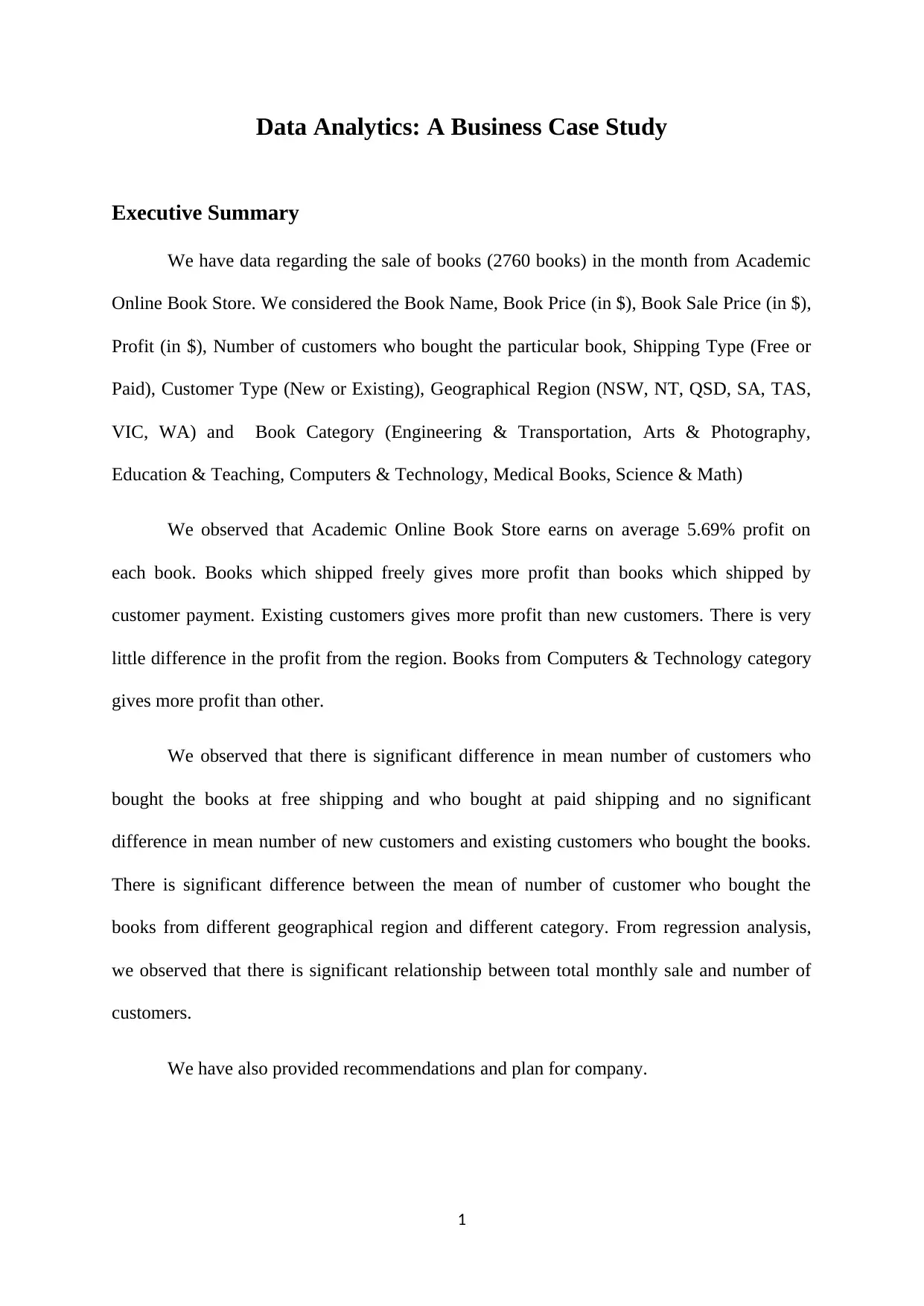
Data Analytics: A Business Case Study
Executive Summary
We have data regarding the sale of books (2760 books) in the month from Academic
Online Book Store. We considered the Book Name, Book Price (in $), Book Sale Price (in $),
Profit (in $), Number of customers who bought the particular book, Shipping Type (Free or
Paid), Customer Type (New or Existing), Geographical Region (NSW, NT, QSD, SA, TAS,
VIC, WA) and Book Category (Engineering & Transportation, Arts & Photography,
Education & Teaching, Computers & Technology, Medical Books, Science & Math)
We observed that Academic Online Book Store earns on average 5.69% profit on
each book. Books which shipped freely gives more profit than books which shipped by
customer payment. Existing customers gives more profit than new customers. There is very
little difference in the profit from the region. Books from Computers & Technology category
gives more profit than other.
We observed that there is significant difference in mean number of customers who
bought the books at free shipping and who bought at paid shipping and no significant
difference in mean number of new customers and existing customers who bought the books.
There is significant difference between the mean of number of customer who bought the
books from different geographical region and different category. From regression analysis,
we observed that there is significant relationship between total monthly sale and number of
customers.
We have also provided recommendations and plan for company.
1
Executive Summary
We have data regarding the sale of books (2760 books) in the month from Academic
Online Book Store. We considered the Book Name, Book Price (in $), Book Sale Price (in $),
Profit (in $), Number of customers who bought the particular book, Shipping Type (Free or
Paid), Customer Type (New or Existing), Geographical Region (NSW, NT, QSD, SA, TAS,
VIC, WA) and Book Category (Engineering & Transportation, Arts & Photography,
Education & Teaching, Computers & Technology, Medical Books, Science & Math)
We observed that Academic Online Book Store earns on average 5.69% profit on
each book. Books which shipped freely gives more profit than books which shipped by
customer payment. Existing customers gives more profit than new customers. There is very
little difference in the profit from the region. Books from Computers & Technology category
gives more profit than other.
We observed that there is significant difference in mean number of customers who
bought the books at free shipping and who bought at paid shipping and no significant
difference in mean number of new customers and existing customers who bought the books.
There is significant difference between the mean of number of customer who bought the
books from different geographical region and different category. From regression analysis,
we observed that there is significant relationship between total monthly sale and number of
customers.
We have also provided recommendations and plan for company.
1
Secure Best Marks with AI Grader
Need help grading? Try our AI Grader for instant feedback on your assignments.
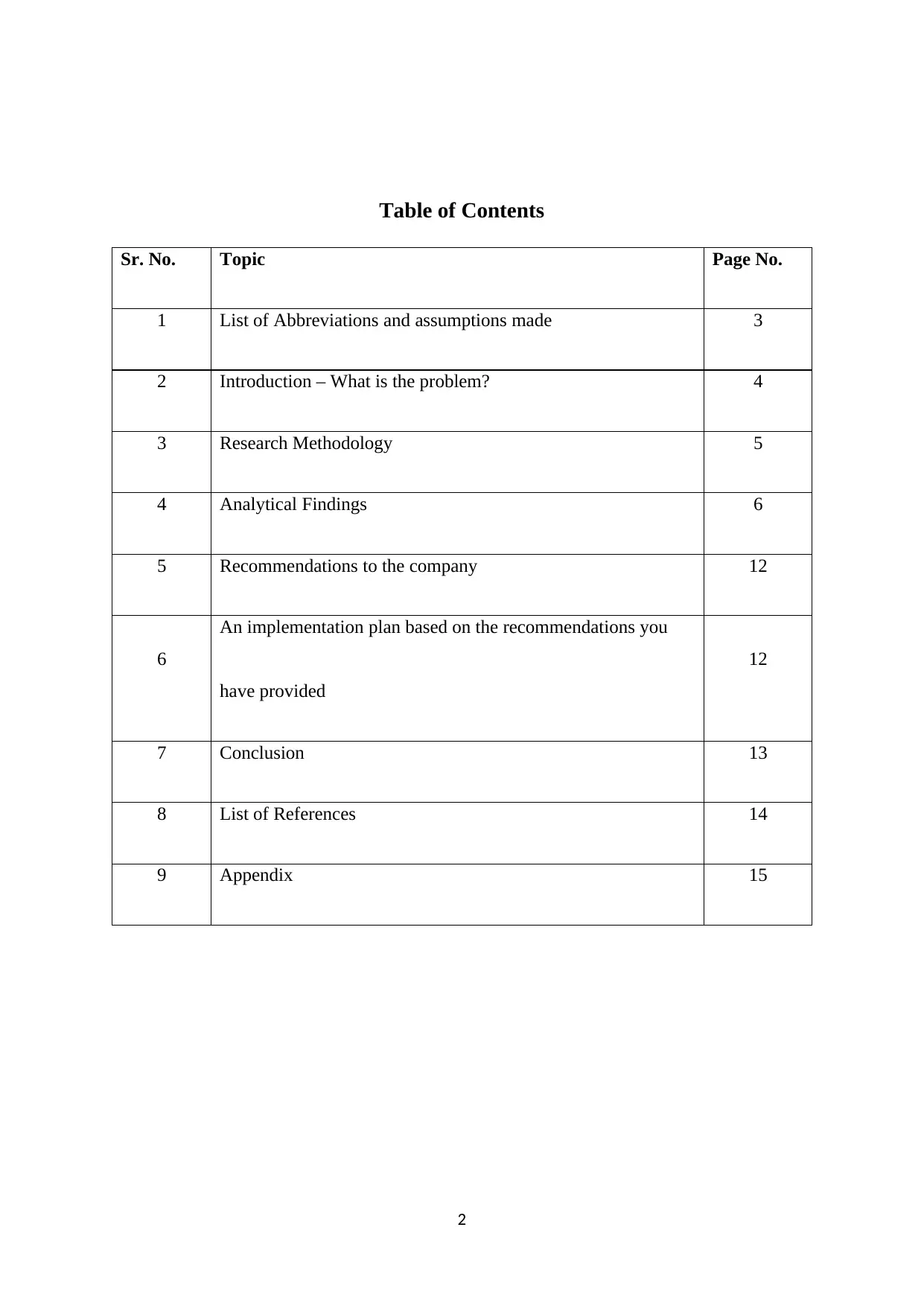
Table of Contents
Sr. No. Topic Page No.
1 List of Abbreviations and assumptions made 3
2 Introduction – What is the problem? 4
3 Research Methodology 5
4 Analytical Findings 6
5 Recommendations to the company 12
6
An implementation plan based on the recommendations you
have provided
12
7 Conclusion 13
8 List of References 14
9 Appendix 15
2
Sr. No. Topic Page No.
1 List of Abbreviations and assumptions made 3
2 Introduction – What is the problem? 4
3 Research Methodology 5
4 Analytical Findings 6
5 Recommendations to the company 12
6
An implementation plan based on the recommendations you
have provided
12
7 Conclusion 13
8 List of References 14
9 Appendix 15
2
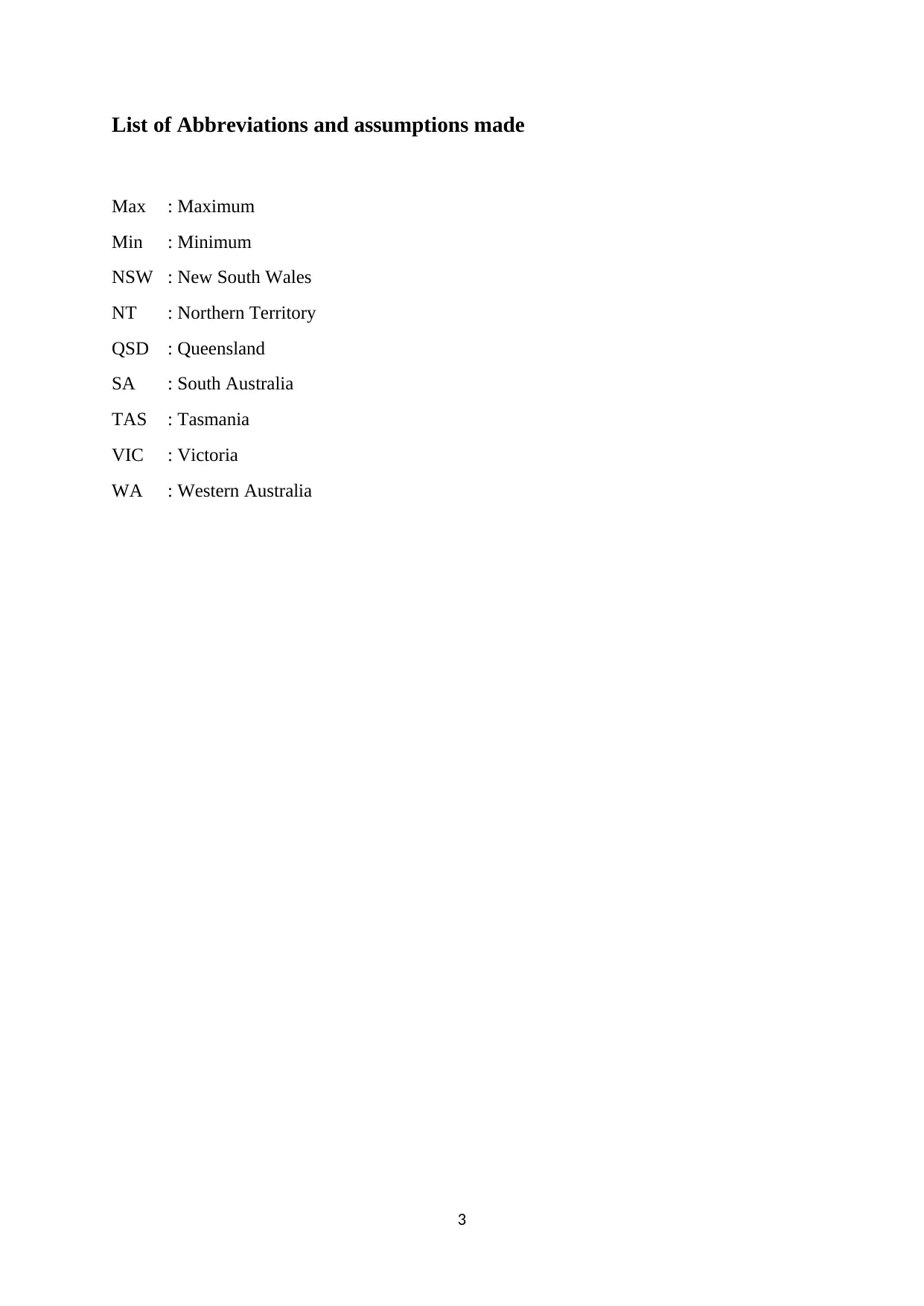
List of Abbreviations and assumptions made
Max : Maximum
Min : Minimum
NSW : New South Wales
NT : Northern Territory
QSD : Queensland
SA : South Australia
TAS : Tasmania
VIC : Victoria
WA : Western Australia
3
Max : Maximum
Min : Minimum
NSW : New South Wales
NT : Northern Territory
QSD : Queensland
SA : South Australia
TAS : Tasmania
VIC : Victoria
WA : Western Australia
3
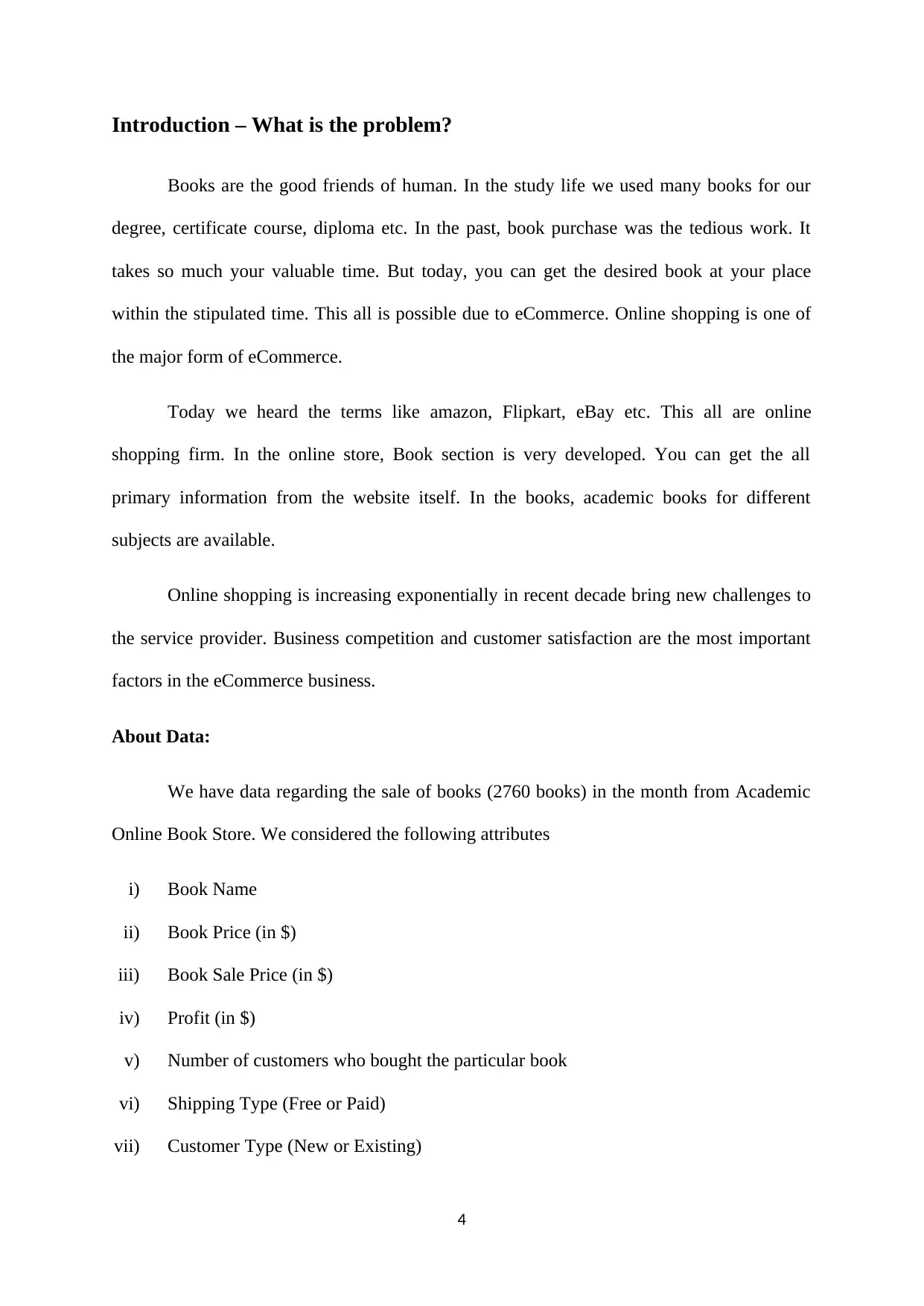
Introduction – What is the problem?
Books are the good friends of human. In the study life we used many books for our
degree, certificate course, diploma etc. In the past, book purchase was the tedious work. It
takes so much your valuable time. But today, you can get the desired book at your place
within the stipulated time. This all is possible due to eCommerce. Online shopping is one of
the major form of eCommerce.
Today we heard the terms like amazon, Flipkart, eBay etc. This all are online
shopping firm. In the online store, Book section is very developed. You can get the all
primary information from the website itself. In the books, academic books for different
subjects are available.
Online shopping is increasing exponentially in recent decade bring new challenges to
the service provider. Business competition and customer satisfaction are the most important
factors in the eCommerce business.
About Data:
We have data regarding the sale of books (2760 books) in the month from Academic
Online Book Store. We considered the following attributes
i) Book Name
ii) Book Price (in $)
iii) Book Sale Price (in $)
iv) Profit (in $)
v) Number of customers who bought the particular book
vi) Shipping Type (Free or Paid)
vii) Customer Type (New or Existing)
4
Books are the good friends of human. In the study life we used many books for our
degree, certificate course, diploma etc. In the past, book purchase was the tedious work. It
takes so much your valuable time. But today, you can get the desired book at your place
within the stipulated time. This all is possible due to eCommerce. Online shopping is one of
the major form of eCommerce.
Today we heard the terms like amazon, Flipkart, eBay etc. This all are online
shopping firm. In the online store, Book section is very developed. You can get the all
primary information from the website itself. In the books, academic books for different
subjects are available.
Online shopping is increasing exponentially in recent decade bring new challenges to
the service provider. Business competition and customer satisfaction are the most important
factors in the eCommerce business.
About Data:
We have data regarding the sale of books (2760 books) in the month from Academic
Online Book Store. We considered the following attributes
i) Book Name
ii) Book Price (in $)
iii) Book Sale Price (in $)
iv) Profit (in $)
v) Number of customers who bought the particular book
vi) Shipping Type (Free or Paid)
vii) Customer Type (New or Existing)
4
Secure Best Marks with AI Grader
Need help grading? Try our AI Grader for instant feedback on your assignments.
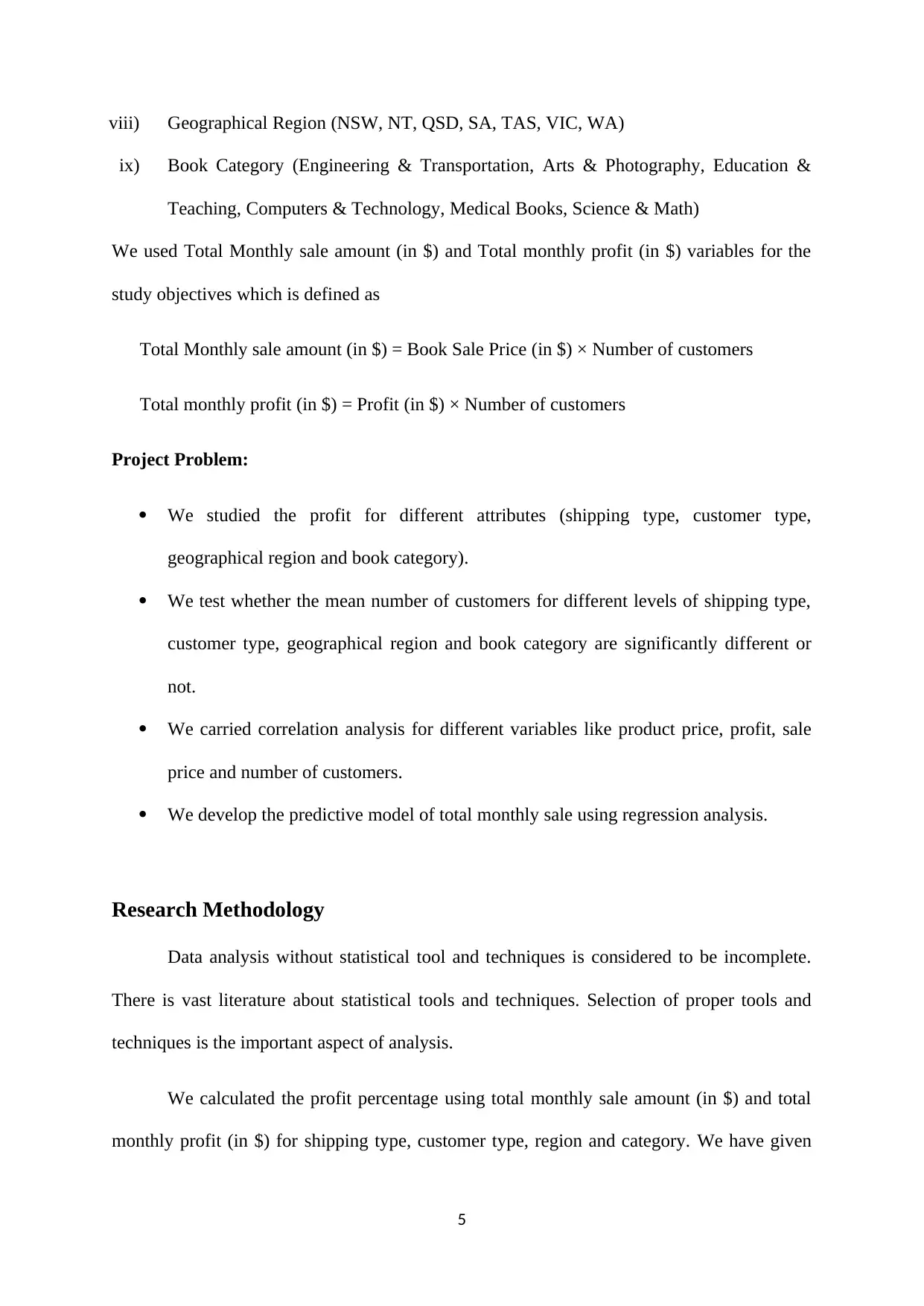
viii) Geographical Region (NSW, NT, QSD, SA, TAS, VIC, WA)
ix) Book Category (Engineering & Transportation, Arts & Photography, Education &
Teaching, Computers & Technology, Medical Books, Science & Math)
We used Total Monthly sale amount (in $) and Total monthly profit (in $) variables for the
study objectives which is defined as
Total Monthly sale amount (in $) = Book Sale Price (in $) × Number of customers
Total monthly profit (in $) = Profit (in $) × Number of customers
Project Problem:
We studied the profit for different attributes (shipping type, customer type,
geographical region and book category).
We test whether the mean number of customers for different levels of shipping type,
customer type, geographical region and book category are significantly different or
not.
We carried correlation analysis for different variables like product price, profit, sale
price and number of customers.
We develop the predictive model of total monthly sale using regression analysis.
Research Methodology
Data analysis without statistical tool and techniques is considered to be incomplete.
There is vast literature about statistical tools and techniques. Selection of proper tools and
techniques is the important aspect of analysis.
We calculated the profit percentage using total monthly sale amount (in $) and total
monthly profit (in $) for shipping type, customer type, region and category. We have given
5
ix) Book Category (Engineering & Transportation, Arts & Photography, Education &
Teaching, Computers & Technology, Medical Books, Science & Math)
We used Total Monthly sale amount (in $) and Total monthly profit (in $) variables for the
study objectives which is defined as
Total Monthly sale amount (in $) = Book Sale Price (in $) × Number of customers
Total monthly profit (in $) = Profit (in $) × Number of customers
Project Problem:
We studied the profit for different attributes (shipping type, customer type,
geographical region and book category).
We test whether the mean number of customers for different levels of shipping type,
customer type, geographical region and book category are significantly different or
not.
We carried correlation analysis for different variables like product price, profit, sale
price and number of customers.
We develop the predictive model of total monthly sale using regression analysis.
Research Methodology
Data analysis without statistical tool and techniques is considered to be incomplete.
There is vast literature about statistical tools and techniques. Selection of proper tools and
techniques is the important aspect of analysis.
We calculated the profit percentage using total monthly sale amount (in $) and total
monthly profit (in $) for shipping type, customer type, region and category. We have given
5
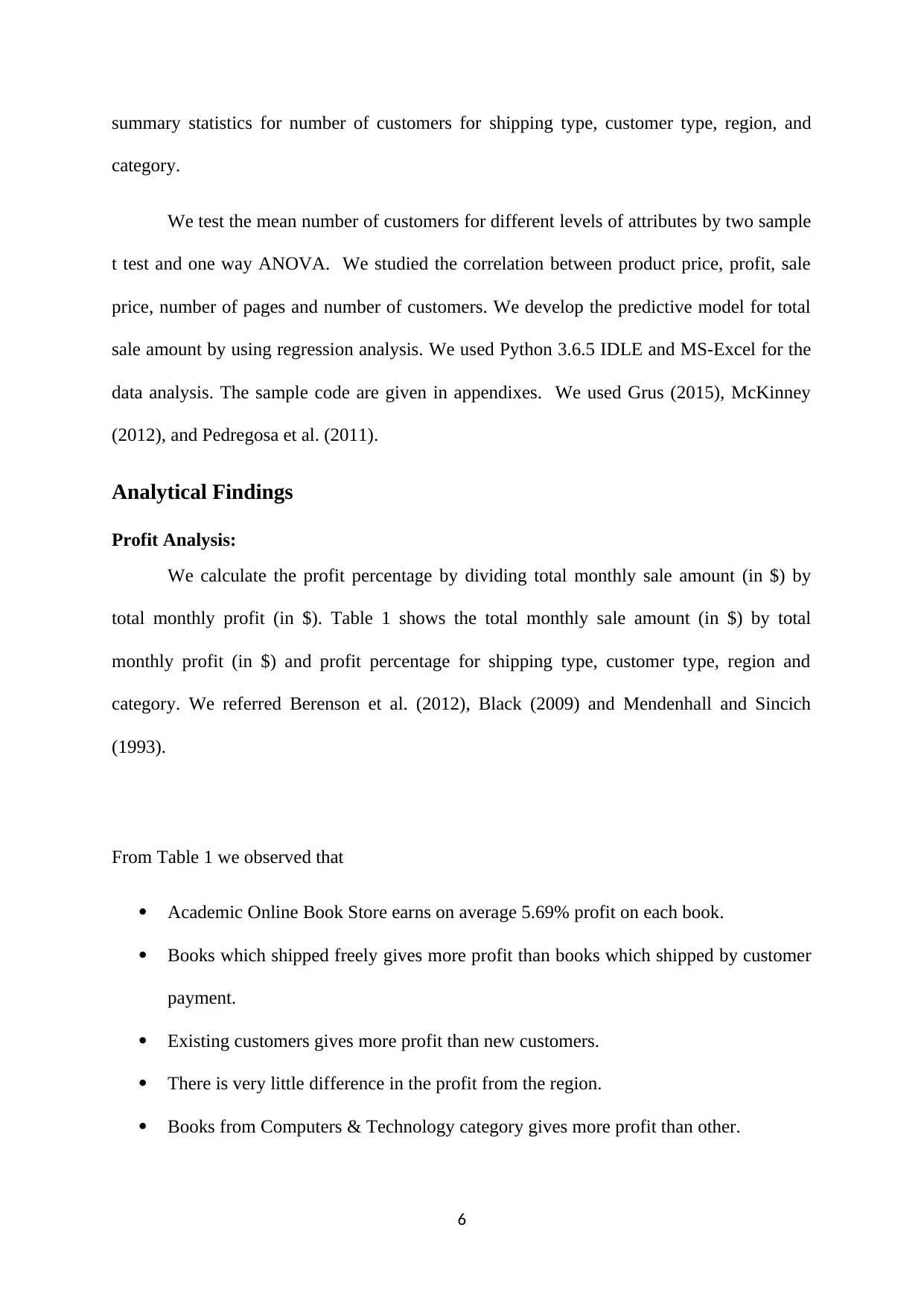
summary statistics for number of customers for shipping type, customer type, region, and
category.
We test the mean number of customers for different levels of attributes by two sample
t test and one way ANOVA. We studied the correlation between product price, profit, sale
price, number of pages and number of customers. We develop the predictive model for total
sale amount by using regression analysis. We used Python 3.6.5 IDLE and MS-Excel for the
data analysis. The sample code are given in appendixes. We used Grus (2015), McKinney
(2012), and Pedregosa et al. (2011).
Analytical Findings
Profit Analysis:
We calculate the profit percentage by dividing total monthly sale amount (in $) by
total monthly profit (in $). Table 1 shows the total monthly sale amount (in $) by total
monthly profit (in $) and profit percentage for shipping type, customer type, region and
category. We referred Berenson et al. (2012), Black (2009) and Mendenhall and Sincich
(1993).
From Table 1 we observed that
Academic Online Book Store earns on average 5.69% profit on each book.
Books which shipped freely gives more profit than books which shipped by customer
payment.
Existing customers gives more profit than new customers.
There is very little difference in the profit from the region.
Books from Computers & Technology category gives more profit than other.
6
category.
We test the mean number of customers for different levels of attributes by two sample
t test and one way ANOVA. We studied the correlation between product price, profit, sale
price, number of pages and number of customers. We develop the predictive model for total
sale amount by using regression analysis. We used Python 3.6.5 IDLE and MS-Excel for the
data analysis. The sample code are given in appendixes. We used Grus (2015), McKinney
(2012), and Pedregosa et al. (2011).
Analytical Findings
Profit Analysis:
We calculate the profit percentage by dividing total monthly sale amount (in $) by
total monthly profit (in $). Table 1 shows the total monthly sale amount (in $) by total
monthly profit (in $) and profit percentage for shipping type, customer type, region and
category. We referred Berenson et al. (2012), Black (2009) and Mendenhall and Sincich
(1993).
From Table 1 we observed that
Academic Online Book Store earns on average 5.69% profit on each book.
Books which shipped freely gives more profit than books which shipped by customer
payment.
Existing customers gives more profit than new customers.
There is very little difference in the profit from the region.
Books from Computers & Technology category gives more profit than other.
6
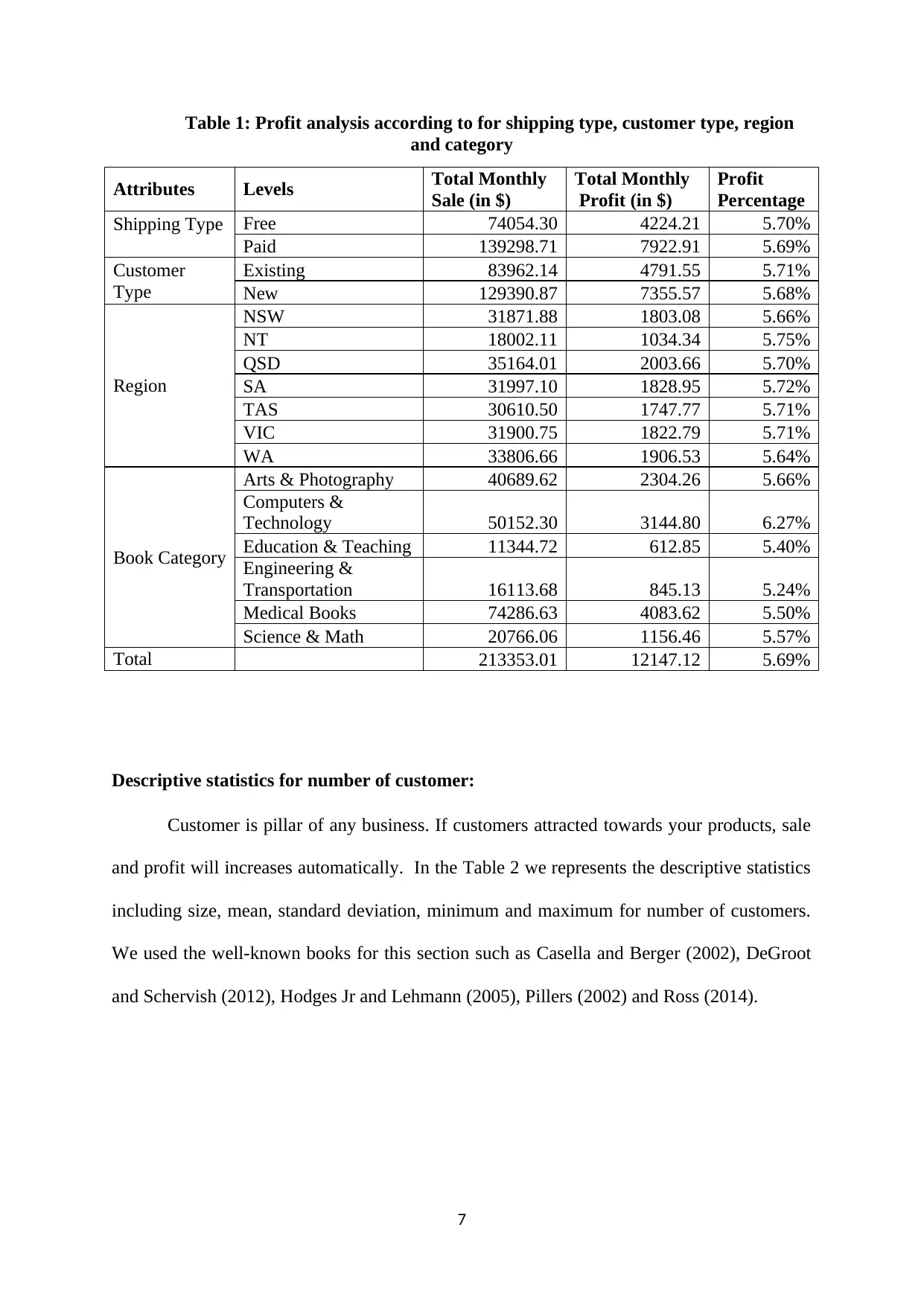
Table 1: Profit analysis according to for shipping type, customer type, region
and category
Attributes Levels Total Monthly
Sale (in $)
Total Monthly
Profit (in $)
Profit
Percentage
Shipping Type Free 74054.30 4224.21 5.70%
Paid 139298.71 7922.91 5.69%
Customer
Type
Existing 83962.14 4791.55 5.71%
New 129390.87 7355.57 5.68%
Region
NSW 31871.88 1803.08 5.66%
NT 18002.11 1034.34 5.75%
QSD 35164.01 2003.66 5.70%
SA 31997.10 1828.95 5.72%
TAS 30610.50 1747.77 5.71%
VIC 31900.75 1822.79 5.71%
WA 33806.66 1906.53 5.64%
Book Category
Arts & Photography 40689.62 2304.26 5.66%
Computers &
Technology 50152.30 3144.80 6.27%
Education & Teaching 11344.72 612.85 5.40%
Engineering &
Transportation 16113.68 845.13 5.24%
Medical Books 74286.63 4083.62 5.50%
Science & Math 20766.06 1156.46 5.57%
Total 213353.01 12147.12 5.69%
Descriptive statistics for number of customer:
Customer is pillar of any business. If customers attracted towards your products, sale
and profit will increases automatically. In the Table 2 we represents the descriptive statistics
including size, mean, standard deviation, minimum and maximum for number of customers.
We used the well-known books for this section such as Casella and Berger (2002), DeGroot
and Schervish (2012), Hodges Jr and Lehmann (2005), Pillers (2002) and Ross (2014).
7
and category
Attributes Levels Total Monthly
Sale (in $)
Total Monthly
Profit (in $)
Profit
Percentage
Shipping Type Free 74054.30 4224.21 5.70%
Paid 139298.71 7922.91 5.69%
Customer
Type
Existing 83962.14 4791.55 5.71%
New 129390.87 7355.57 5.68%
Region
NSW 31871.88 1803.08 5.66%
NT 18002.11 1034.34 5.75%
QSD 35164.01 2003.66 5.70%
SA 31997.10 1828.95 5.72%
TAS 30610.50 1747.77 5.71%
VIC 31900.75 1822.79 5.71%
WA 33806.66 1906.53 5.64%
Book Category
Arts & Photography 40689.62 2304.26 5.66%
Computers &
Technology 50152.30 3144.80 6.27%
Education & Teaching 11344.72 612.85 5.40%
Engineering &
Transportation 16113.68 845.13 5.24%
Medical Books 74286.63 4083.62 5.50%
Science & Math 20766.06 1156.46 5.57%
Total 213353.01 12147.12 5.69%
Descriptive statistics for number of customer:
Customer is pillar of any business. If customers attracted towards your products, sale
and profit will increases automatically. In the Table 2 we represents the descriptive statistics
including size, mean, standard deviation, minimum and maximum for number of customers.
We used the well-known books for this section such as Casella and Berger (2002), DeGroot
and Schervish (2012), Hodges Jr and Lehmann (2005), Pillers (2002) and Ross (2014).
7
Paraphrase This Document
Need a fresh take? Get an instant paraphrase of this document with our AI Paraphraser
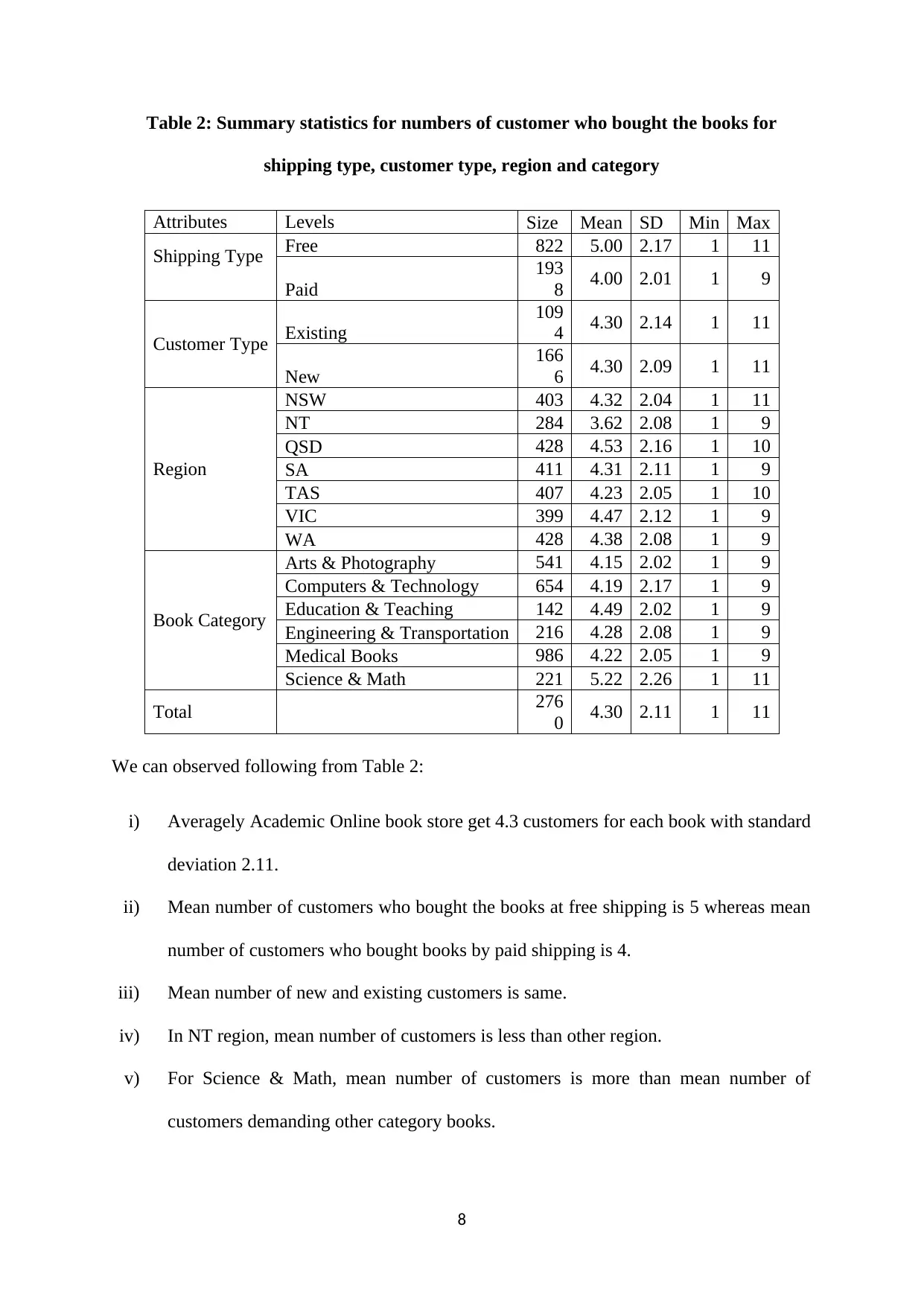
Table 2: Summary statistics for numbers of customer who bought the books for
shipping type, customer type, region and category
Attributes Levels Size Mean SD Min Max
Shipping Type Free 822 5.00 2.17 1 11
Paid
193
8 4.00 2.01 1 9
Customer Type Existing
109
4 4.30 2.14 1 11
New
166
6 4.30 2.09 1 11
Region
NSW 403 4.32 2.04 1 11
NT 284 3.62 2.08 1 9
QSD 428 4.53 2.16 1 10
SA 411 4.31 2.11 1 9
TAS 407 4.23 2.05 1 10
VIC 399 4.47 2.12 1 9
WA 428 4.38 2.08 1 9
Book Category
Arts & Photography 541 4.15 2.02 1 9
Computers & Technology 654 4.19 2.17 1 9
Education & Teaching 142 4.49 2.02 1 9
Engineering & Transportation 216 4.28 2.08 1 9
Medical Books 986 4.22 2.05 1 9
Science & Math 221 5.22 2.26 1 11
Total 276
0 4.30 2.11 1 11
We can observed following from Table 2:
i) Averagely Academic Online book store get 4.3 customers for each book with standard
deviation 2.11.
ii) Mean number of customers who bought the books at free shipping is 5 whereas mean
number of customers who bought books by paid shipping is 4.
iii) Mean number of new and existing customers is same.
iv) In NT region, mean number of customers is less than other region.
v) For Science & Math, mean number of customers is more than mean number of
customers demanding other category books.
8
shipping type, customer type, region and category
Attributes Levels Size Mean SD Min Max
Shipping Type Free 822 5.00 2.17 1 11
Paid
193
8 4.00 2.01 1 9
Customer Type Existing
109
4 4.30 2.14 1 11
New
166
6 4.30 2.09 1 11
Region
NSW 403 4.32 2.04 1 11
NT 284 3.62 2.08 1 9
QSD 428 4.53 2.16 1 10
SA 411 4.31 2.11 1 9
TAS 407 4.23 2.05 1 10
VIC 399 4.47 2.12 1 9
WA 428 4.38 2.08 1 9
Book Category
Arts & Photography 541 4.15 2.02 1 9
Computers & Technology 654 4.19 2.17 1 9
Education & Teaching 142 4.49 2.02 1 9
Engineering & Transportation 216 4.28 2.08 1 9
Medical Books 986 4.22 2.05 1 9
Science & Math 221 5.22 2.26 1 11
Total 276
0 4.30 2.11 1 11
We can observed following from Table 2:
i) Averagely Academic Online book store get 4.3 customers for each book with standard
deviation 2.11.
ii) Mean number of customers who bought the books at free shipping is 5 whereas mean
number of customers who bought books by paid shipping is 4.
iii) Mean number of new and existing customers is same.
iv) In NT region, mean number of customers is less than other region.
v) For Science & Math, mean number of customers is more than mean number of
customers demanding other category books.
8
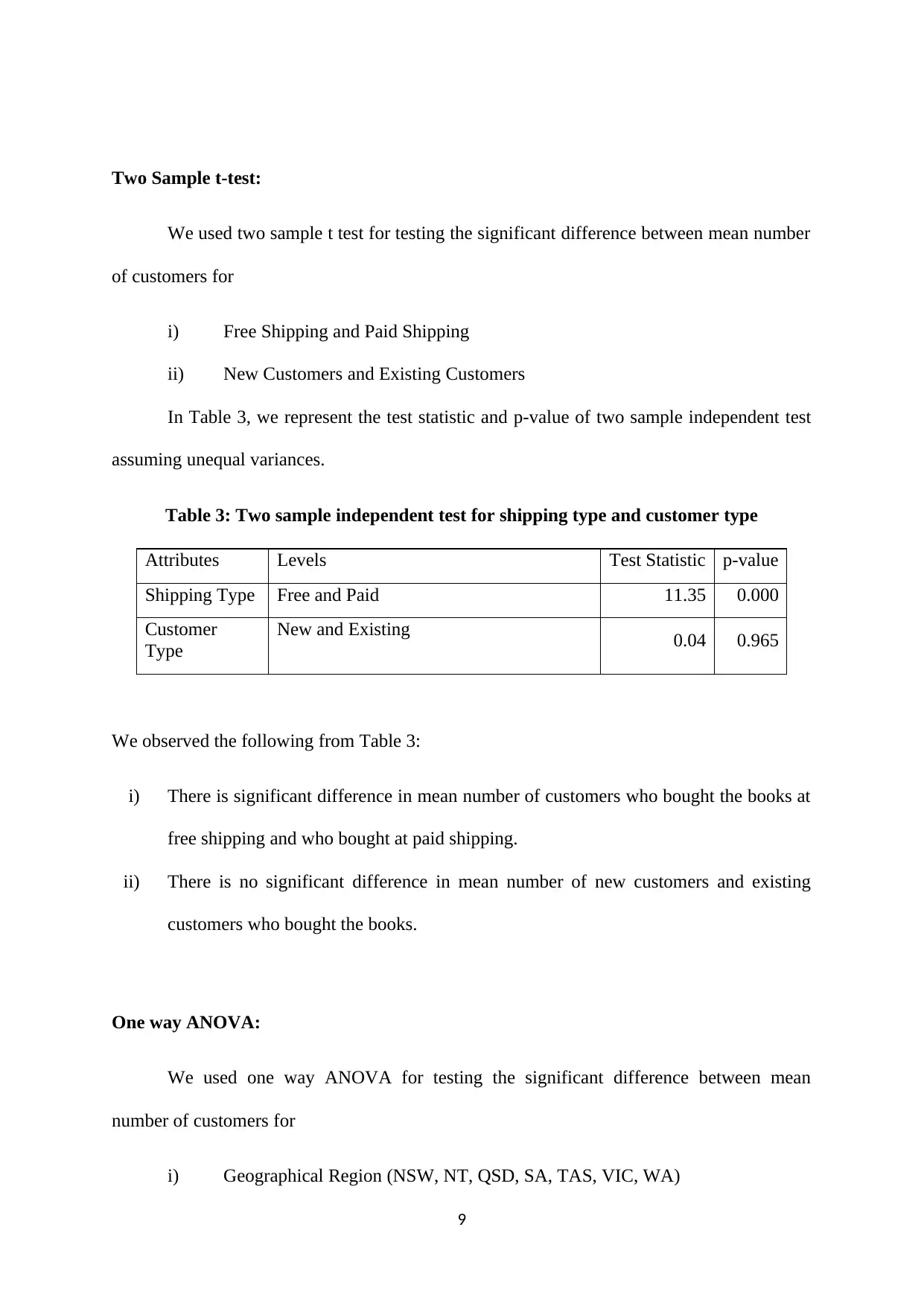
Two Sample t-test:
We used two sample t test for testing the significant difference between mean number
of customers for
i) Free Shipping and Paid Shipping
ii) New Customers and Existing Customers
In Table 3, we represent the test statistic and p-value of two sample independent test
assuming unequal variances.
Table 3: Two sample independent test for shipping type and customer type
Attributes Levels Test Statistic p-value
Shipping Type Free and Paid 11.35 0.000
Customer
Type
New and Existing 0.04 0.965
We observed the following from Table 3:
i) There is significant difference in mean number of customers who bought the books at
free shipping and who bought at paid shipping.
ii) There is no significant difference in mean number of new customers and existing
customers who bought the books.
One way ANOVA:
We used one way ANOVA for testing the significant difference between mean
number of customers for
i) Geographical Region (NSW, NT, QSD, SA, TAS, VIC, WA)
9
We used two sample t test for testing the significant difference between mean number
of customers for
i) Free Shipping and Paid Shipping
ii) New Customers and Existing Customers
In Table 3, we represent the test statistic and p-value of two sample independent test
assuming unequal variances.
Table 3: Two sample independent test for shipping type and customer type
Attributes Levels Test Statistic p-value
Shipping Type Free and Paid 11.35 0.000
Customer
Type
New and Existing 0.04 0.965
We observed the following from Table 3:
i) There is significant difference in mean number of customers who bought the books at
free shipping and who bought at paid shipping.
ii) There is no significant difference in mean number of new customers and existing
customers who bought the books.
One way ANOVA:
We used one way ANOVA for testing the significant difference between mean
number of customers for
i) Geographical Region (NSW, NT, QSD, SA, TAS, VIC, WA)
9
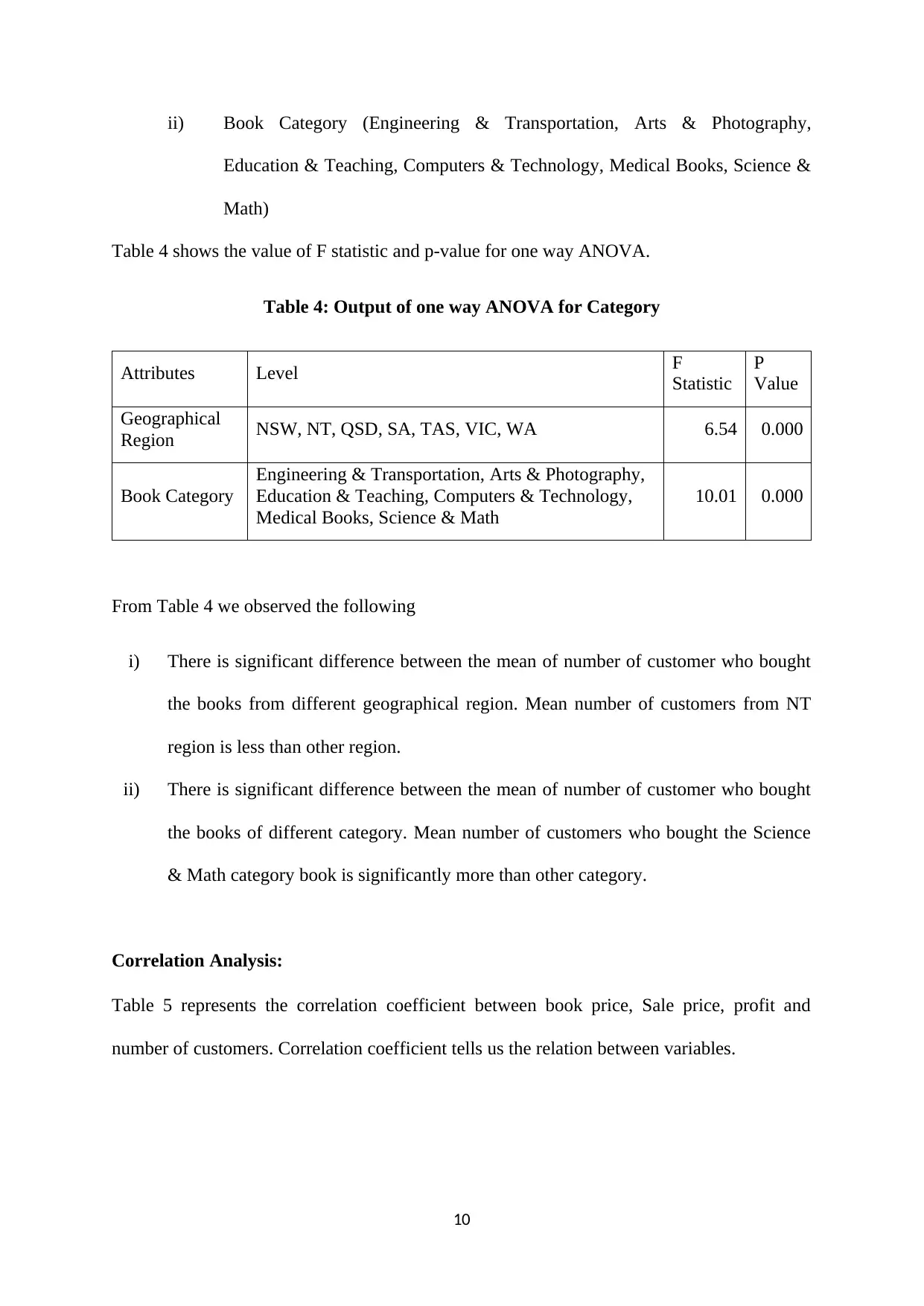
ii) Book Category (Engineering & Transportation, Arts & Photography,
Education & Teaching, Computers & Technology, Medical Books, Science &
Math)
Table 4 shows the value of F statistic and p-value for one way ANOVA.
Table 4: Output of one way ANOVA for Category
Attributes Level F
Statistic
P
Value
Geographical
Region NSW, NT, QSD, SA, TAS, VIC, WA 6.54 0.000
Book Category
Engineering & Transportation, Arts & Photography,
Education & Teaching, Computers & Technology,
Medical Books, Science & Math
10.01 0.000
From Table 4 we observed the following
i) There is significant difference between the mean of number of customer who bought
the books from different geographical region. Mean number of customers from NT
region is less than other region.
ii) There is significant difference between the mean of number of customer who bought
the books of different category. Mean number of customers who bought the Science
& Math category book is significantly more than other category.
Correlation Analysis:
Table 5 represents the correlation coefficient between book price, Sale price, profit and
number of customers. Correlation coefficient tells us the relation between variables.
10
Education & Teaching, Computers & Technology, Medical Books, Science &
Math)
Table 4 shows the value of F statistic and p-value for one way ANOVA.
Table 4: Output of one way ANOVA for Category
Attributes Level F
Statistic
P
Value
Geographical
Region NSW, NT, QSD, SA, TAS, VIC, WA 6.54 0.000
Book Category
Engineering & Transportation, Arts & Photography,
Education & Teaching, Computers & Technology,
Medical Books, Science & Math
10.01 0.000
From Table 4 we observed the following
i) There is significant difference between the mean of number of customer who bought
the books from different geographical region. Mean number of customers from NT
region is less than other region.
ii) There is significant difference between the mean of number of customer who bought
the books of different category. Mean number of customers who bought the Science
& Math category book is significantly more than other category.
Correlation Analysis:
Table 5 represents the correlation coefficient between book price, Sale price, profit and
number of customers. Correlation coefficient tells us the relation between variables.
10
Secure Best Marks with AI Grader
Need help grading? Try our AI Grader for instant feedback on your assignments.
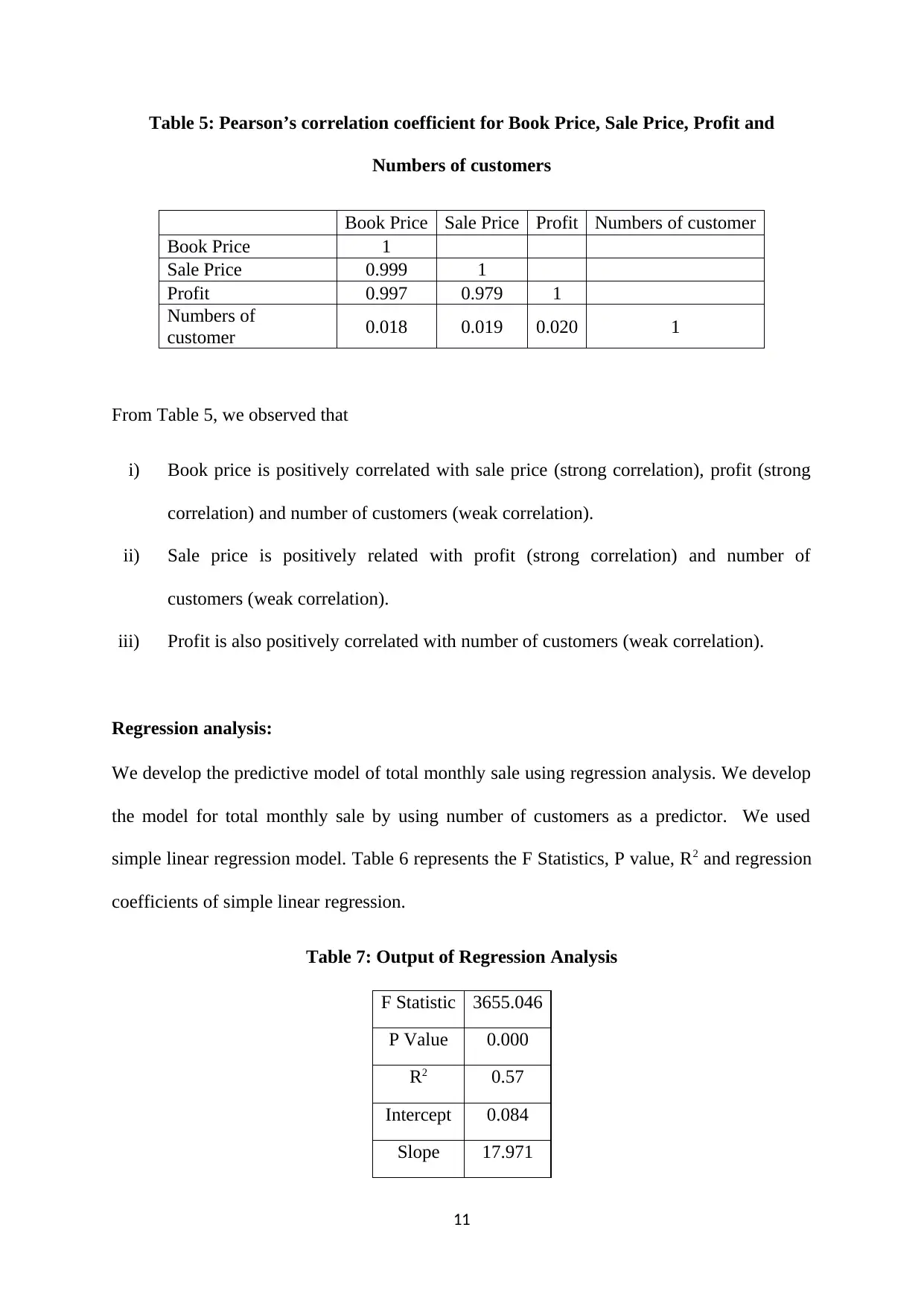
Table 5: Pearson’s correlation coefficient for Book Price, Sale Price, Profit and
Numbers of customers
Book Price Sale Price Profit Numbers of customer
Book Price 1
Sale Price 0.999 1
Profit 0.997 0.979 1
Numbers of
customer 0.018 0.019 0.020 1
From Table 5, we observed that
i) Book price is positively correlated with sale price (strong correlation), profit (strong
correlation) and number of customers (weak correlation).
ii) Sale price is positively related with profit (strong correlation) and number of
customers (weak correlation).
iii) Profit is also positively correlated with number of customers (weak correlation).
Regression analysis:
We develop the predictive model of total monthly sale using regression analysis. We develop
the model for total monthly sale by using number of customers as a predictor. We used
simple linear regression model. Table 6 represents the F Statistics, P value, R2 and regression
coefficients of simple linear regression.
Table 7: Output of Regression Analysis
F Statistic 3655.046
P Value 0.000
R2 0.57
Intercept 0.084
Slope 17.971
11
Numbers of customers
Book Price Sale Price Profit Numbers of customer
Book Price 1
Sale Price 0.999 1
Profit 0.997 0.979 1
Numbers of
customer 0.018 0.019 0.020 1
From Table 5, we observed that
i) Book price is positively correlated with sale price (strong correlation), profit (strong
correlation) and number of customers (weak correlation).
ii) Sale price is positively related with profit (strong correlation) and number of
customers (weak correlation).
iii) Profit is also positively correlated with number of customers (weak correlation).
Regression analysis:
We develop the predictive model of total monthly sale using regression analysis. We develop
the model for total monthly sale by using number of customers as a predictor. We used
simple linear regression model. Table 6 represents the F Statistics, P value, R2 and regression
coefficients of simple linear regression.
Table 7: Output of Regression Analysis
F Statistic 3655.046
P Value 0.000
R2 0.57
Intercept 0.084
Slope 17.971
11
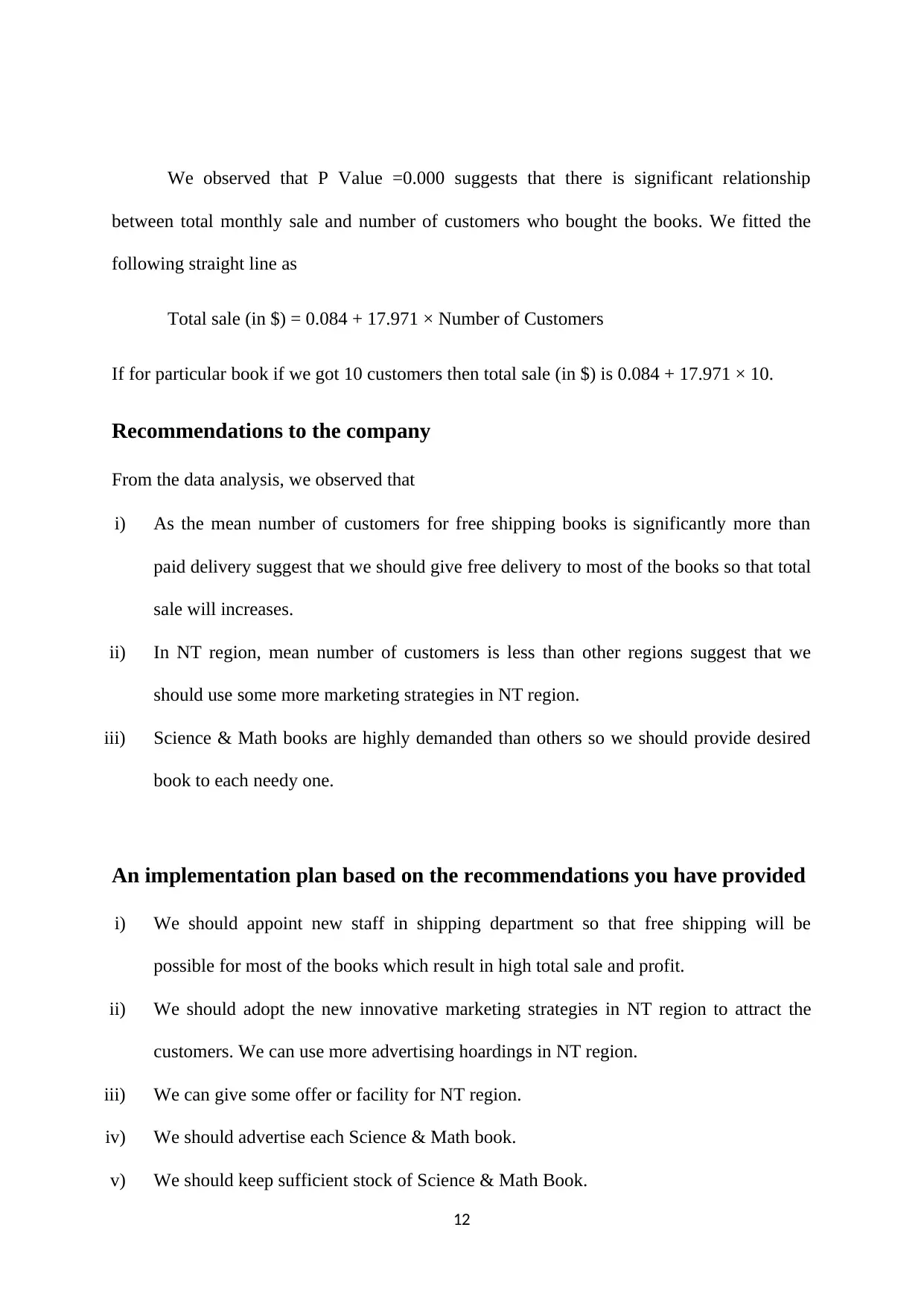
We observed that P Value =0.000 suggests that there is significant relationship
between total monthly sale and number of customers who bought the books. We fitted the
following straight line as
Total sale (in $) = 0.084 + 17.971 × Number of Customers
If for particular book if we got 10 customers then total sale (in $) is 0.084 + 17.971 × 10.
Recommendations to the company
From the data analysis, we observed that
i) As the mean number of customers for free shipping books is significantly more than
paid delivery suggest that we should give free delivery to most of the books so that total
sale will increases.
ii) In NT region, mean number of customers is less than other regions suggest that we
should use some more marketing strategies in NT region.
iii) Science & Math books are highly demanded than others so we should provide desired
book to each needy one.
An implementation plan based on the recommendations you have provided
i) We should appoint new staff in shipping department so that free shipping will be
possible for most of the books which result in high total sale and profit.
ii) We should adopt the new innovative marketing strategies in NT region to attract the
customers. We can use more advertising hoardings in NT region.
iii) We can give some offer or facility for NT region.
iv) We should advertise each Science & Math book.
v) We should keep sufficient stock of Science & Math Book.
12
between total monthly sale and number of customers who bought the books. We fitted the
following straight line as
Total sale (in $) = 0.084 + 17.971 × Number of Customers
If for particular book if we got 10 customers then total sale (in $) is 0.084 + 17.971 × 10.
Recommendations to the company
From the data analysis, we observed that
i) As the mean number of customers for free shipping books is significantly more than
paid delivery suggest that we should give free delivery to most of the books so that total
sale will increases.
ii) In NT region, mean number of customers is less than other regions suggest that we
should use some more marketing strategies in NT region.
iii) Science & Math books are highly demanded than others so we should provide desired
book to each needy one.
An implementation plan based on the recommendations you have provided
i) We should appoint new staff in shipping department so that free shipping will be
possible for most of the books which result in high total sale and profit.
ii) We should adopt the new innovative marketing strategies in NT region to attract the
customers. We can use more advertising hoardings in NT region.
iii) We can give some offer or facility for NT region.
iv) We should advertise each Science & Math book.
v) We should keep sufficient stock of Science & Math Book.
12
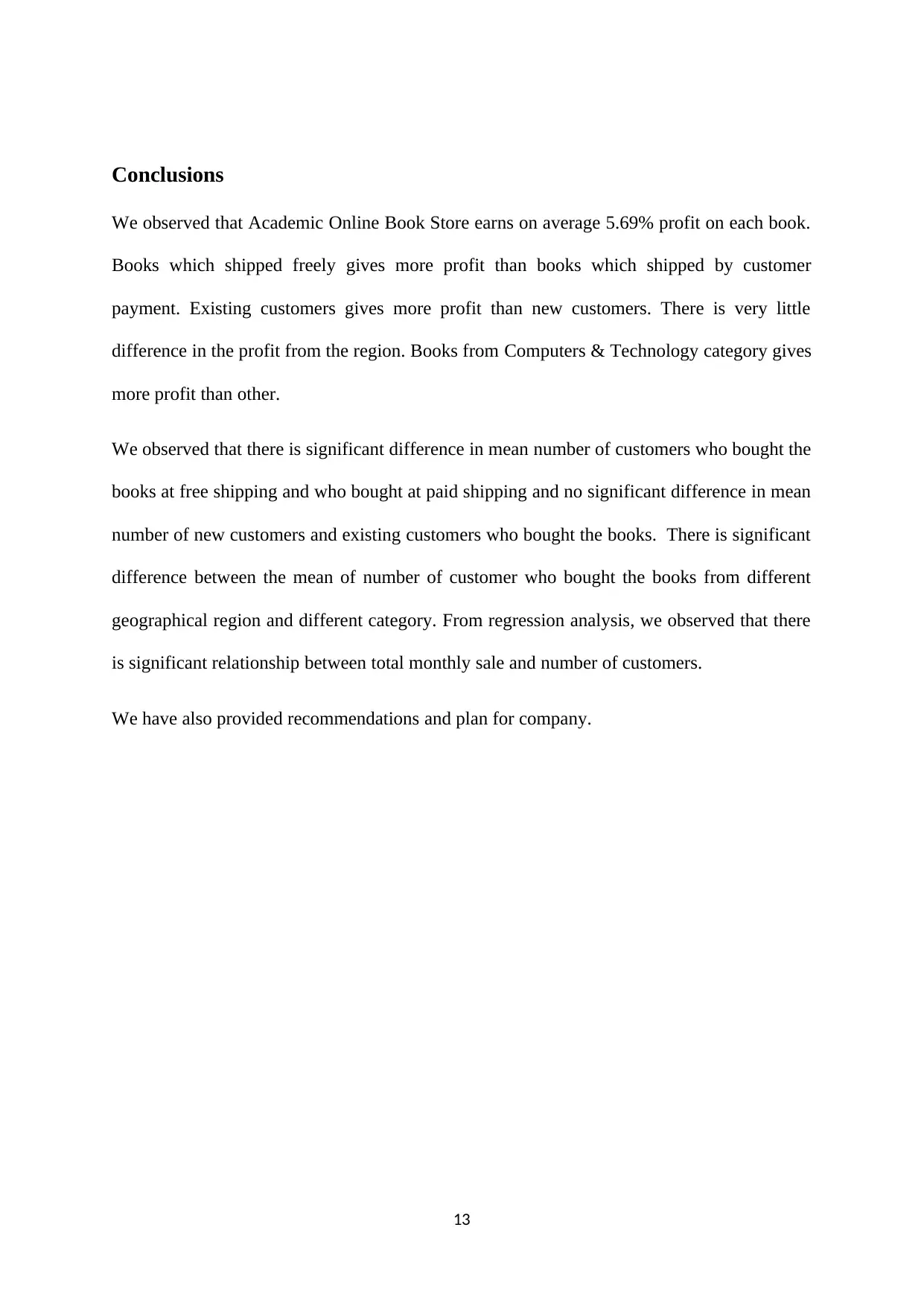
Conclusions
We observed that Academic Online Book Store earns on average 5.69% profit on each book.
Books which shipped freely gives more profit than books which shipped by customer
payment. Existing customers gives more profit than new customers. There is very little
difference in the profit from the region. Books from Computers & Technology category gives
more profit than other.
We observed that there is significant difference in mean number of customers who bought the
books at free shipping and who bought at paid shipping and no significant difference in mean
number of new customers and existing customers who bought the books. There is significant
difference between the mean of number of customer who bought the books from different
geographical region and different category. From regression analysis, we observed that there
is significant relationship between total monthly sale and number of customers.
We have also provided recommendations and plan for company.
13
We observed that Academic Online Book Store earns on average 5.69% profit on each book.
Books which shipped freely gives more profit than books which shipped by customer
payment. Existing customers gives more profit than new customers. There is very little
difference in the profit from the region. Books from Computers & Technology category gives
more profit than other.
We observed that there is significant difference in mean number of customers who bought the
books at free shipping and who bought at paid shipping and no significant difference in mean
number of new customers and existing customers who bought the books. There is significant
difference between the mean of number of customer who bought the books from different
geographical region and different category. From regression analysis, we observed that there
is significant relationship between total monthly sale and number of customers.
We have also provided recommendations and plan for company.
13
Paraphrase This Document
Need a fresh take? Get an instant paraphrase of this document with our AI Paraphraser

List of References
1. Berenson, M., Levine, D., Szabat, K.A. and Krehbiel, T.C., 2012. Basic business
statistics: Concepts and applications. Pearson higher education AU.
2. Black, K., 2009. Business statistics: Contemporary decision making. John Wiley &
Sons.
3. Casella, G. and Berger, R.L., 2002. Statistical inference (Vol. 2). Pacific Grove, CA:
Duxbury.
4. DeGroot, M.H. and Schervish, M.J., 2012. Probability and statistics. Pearson
Education.
5. Grus, J., 2015. Data science from scratch: first principles with python. " O'Reilly
Media, Inc.".
6. Hodges Jr, J.L. and Lehmann, E.L., 2005. Basic concepts of probability and statistics.
Society for industrial and applied mathematics.
7. Lee, G.G. and Lin, H.F., 2005. Customer perceptions of e-service quality in online
shopping. International Journal of Retail & Distribution Management, 33(2), pp.161-
176.
8. McKinney, W., 2012. Python for data analysis: Data wrangling with Pandas,
NumPy, and IPython. " O'Reilly Media, Inc.".
9. Mendenhall, W. and Sincich, T., 1993. A second course in business statistics:
Regression analysis. San Francisco: Dellen.
10. Pedregosa, F., Varoquaux, G., Gramfort, A., Michel, V., Thirion, B., Grisel, O.,
Blondel, M., Prettenhofer, P., Weiss, R., Dubourg, V. and Vanderplas, J., 2011.
Scikit-learn: Machine learning in Python. Journal of machine learning research,
12(Oct), pp.2825-2830.
11. Pillers Dobler, C., 2002. Mathematical statistics: Basic ideas and selected topics.
12. Ross, S.M., 2014. Introduction to probability and statistics for engineers and
scientists. Academic Press.
13. Wolfinbarger, M. and Gilly, M.C., 2001. Shopping online for freedom, control, and
fun. California Management Review, 43(2), pp.34-55.
14
1. Berenson, M., Levine, D., Szabat, K.A. and Krehbiel, T.C., 2012. Basic business
statistics: Concepts and applications. Pearson higher education AU.
2. Black, K., 2009. Business statistics: Contemporary decision making. John Wiley &
Sons.
3. Casella, G. and Berger, R.L., 2002. Statistical inference (Vol. 2). Pacific Grove, CA:
Duxbury.
4. DeGroot, M.H. and Schervish, M.J., 2012. Probability and statistics. Pearson
Education.
5. Grus, J., 2015. Data science from scratch: first principles with python. " O'Reilly
Media, Inc.".
6. Hodges Jr, J.L. and Lehmann, E.L., 2005. Basic concepts of probability and statistics.
Society for industrial and applied mathematics.
7. Lee, G.G. and Lin, H.F., 2005. Customer perceptions of e-service quality in online
shopping. International Journal of Retail & Distribution Management, 33(2), pp.161-
176.
8. McKinney, W., 2012. Python for data analysis: Data wrangling with Pandas,
NumPy, and IPython. " O'Reilly Media, Inc.".
9. Mendenhall, W. and Sincich, T., 1993. A second course in business statistics:
Regression analysis. San Francisco: Dellen.
10. Pedregosa, F., Varoquaux, G., Gramfort, A., Michel, V., Thirion, B., Grisel, O.,
Blondel, M., Prettenhofer, P., Weiss, R., Dubourg, V. and Vanderplas, J., 2011.
Scikit-learn: Machine learning in Python. Journal of machine learning research,
12(Oct), pp.2825-2830.
11. Pillers Dobler, C., 2002. Mathematical statistics: Basic ideas and selected topics.
12. Ross, S.M., 2014. Introduction to probability and statistics for engineers and
scientists. Academic Press.
13. Wolfinbarger, M. and Gilly, M.C., 2001. Shopping online for freedom, control, and
fun. California Management Review, 43(2), pp.34-55.
14
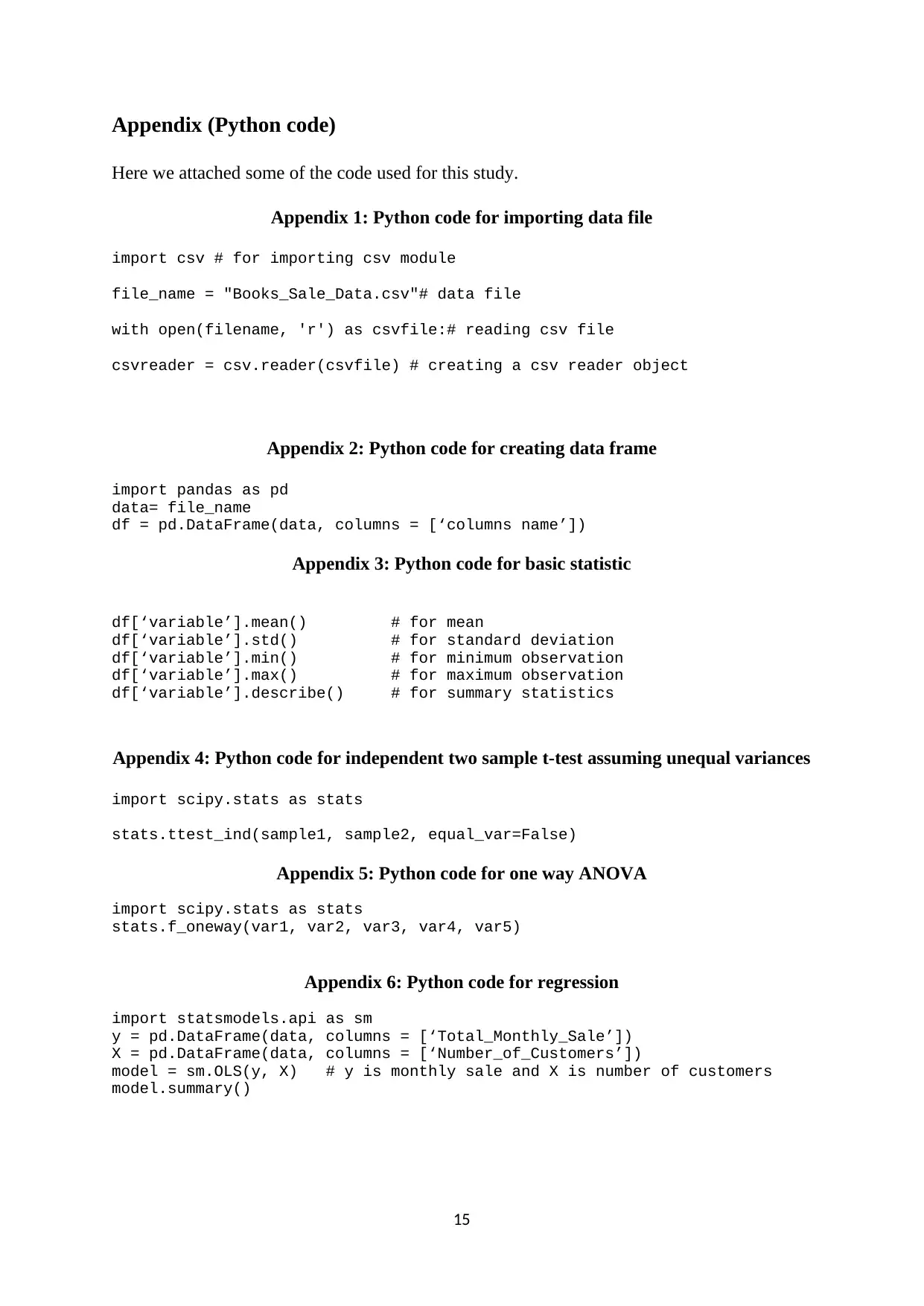
Appendix (Python code)
Here we attached some of the code used for this study.
Appendix 1: Python code for importing data file
import csv # for importing csv module
file_name = "Books_Sale_Data.csv"# data file
with open(filename, 'r') as csvfile:# reading csv file
csvreader = csv.reader(csvfile) # creating a csv reader object
Appendix 2: Python code for creating data frame
import pandas as pd
data= file_name
df = pd.DataFrame(data, columns = [‘columns name’])
Appendix 3: Python code for basic statistic
df[‘variable’].mean() # for mean
df[‘variable’].std() # for standard deviation
df[‘variable’].min() # for minimum observation
df[‘variable’].max() # for maximum observation
df[‘variable’].describe() # for summary statistics
Appendix 4: Python code for independent two sample t-test assuming unequal variances
import scipy.stats as stats
stats.ttest_ind(sample1, sample2, equal_var=False)
Appendix 5: Python code for one way ANOVA
import scipy.stats as stats
stats.f_oneway(var1, var2, var3, var4, var5)
Appendix 6: Python code for regression
import statsmodels.api as sm
y = pd.DataFrame(data, columns = [‘Total_Monthly_Sale’])
X = pd.DataFrame(data, columns = [‘Number_of_Customers’])
model = sm.OLS(y, X) # y is monthly sale and X is number of customers
model.summary()
15
Here we attached some of the code used for this study.
Appendix 1: Python code for importing data file
import csv # for importing csv module
file_name = "Books_Sale_Data.csv"# data file
with open(filename, 'r') as csvfile:# reading csv file
csvreader = csv.reader(csvfile) # creating a csv reader object
Appendix 2: Python code for creating data frame
import pandas as pd
data= file_name
df = pd.DataFrame(data, columns = [‘columns name’])
Appendix 3: Python code for basic statistic
df[‘variable’].mean() # for mean
df[‘variable’].std() # for standard deviation
df[‘variable’].min() # for minimum observation
df[‘variable’].max() # for maximum observation
df[‘variable’].describe() # for summary statistics
Appendix 4: Python code for independent two sample t-test assuming unequal variances
import scipy.stats as stats
stats.ttest_ind(sample1, sample2, equal_var=False)
Appendix 5: Python code for one way ANOVA
import scipy.stats as stats
stats.f_oneway(var1, var2, var3, var4, var5)
Appendix 6: Python code for regression
import statsmodels.api as sm
y = pd.DataFrame(data, columns = [‘Total_Monthly_Sale’])
X = pd.DataFrame(data, columns = [‘Number_of_Customers’])
model = sm.OLS(y, X) # y is monthly sale and X is number of customers
model.summary()
15
1 out of 15
Related Documents
Your All-in-One AI-Powered Toolkit for Academic Success.
+13062052269
info@desklib.com
Available 24*7 on WhatsApp / Email
![[object Object]](/_next/static/media/star-bottom.7253800d.svg)
Unlock your academic potential
© 2024 | Zucol Services PVT LTD | All rights reserved.



